2015+ESPEN共识声明:营养不良的诊断标准
- 格式:pdf
- 大小:580.10 KB
- 文档页数:6
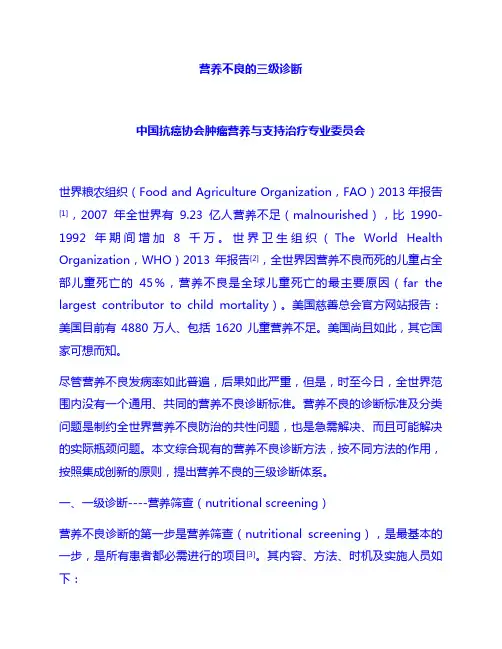
营养不良的三级诊断中国抗癌协会肿瘤营养与支持治疗专业委员会世界粮农组织(Food and Agriculture Organization,FAO)2013年报告[1],2007年全世界有9.23亿人营养不足(malnourished),比1990-1992年期间增加8千万。
世界卫生组织(The World Health Organization,WHO)2013年报告[2],全世界因营养不良而死的儿童占全部儿童死亡的45%,营养不良是全球儿童死亡的最主要原因(far the largest contributor to child mortality)。
美国慈善总会官方网站报告:美国目前有4880万人、包括1620儿童营养不足。
美国尚且如此,其它国家可想而知。
尽管营养不良发病率如此普遍,后果如此严重,但是,时至今日,全世界范围内没有一个通用、共同的营养不良诊断标准。
营养不良的诊断标准及分类问题是制约全世界营养不良防治的共性问题,也是急需解决、而且可能解决的实际瓶颈问题。
本文综合现有的营养不良诊断方法,按不同方法的作用,按照集成创新的原则,提出营养不良的三级诊断体系。
一、一级诊断----营养筛查(nutritional screening)营养不良诊断的第一步是营养筛查(nutritional screening),是最基本的一步,是所有患者都必需进行的项目[3]。
其内容、方法、时机及实施人员如下:(一)内容Kondrup J等[4]人认为:营养筛查是一个在全部患者中,快速识别需要营养支持的患者的过程,该工作由办理入院手续的护士实施。
营养筛查包括营养风险筛查、营养不良风险筛查及营养不良筛查三方面内容。
1.营养风险筛查ESPEN[3]将营养风险(Nutrition Risk)定义为现存的或潜在的与营养因素相关的导致患者出现不利临床结局的风险。
是指与营养因素有关的、出现临床并发症的风险,而不是指出现营养不良的风险。
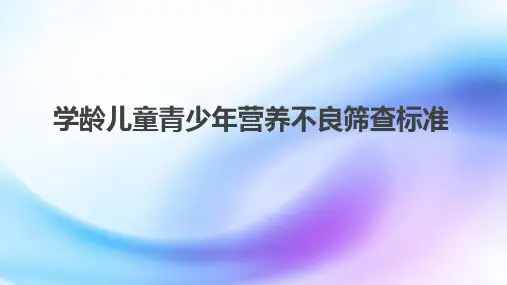
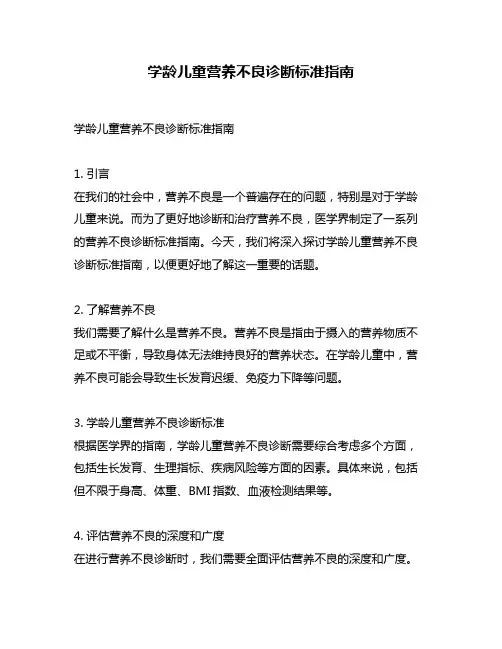
学龄儿童营养不良诊断标准指南学龄儿童营养不良诊断标准指南1. 引言在我们的社会中,营养不良是一个普遍存在的问题,特别是对于学龄儿童来说。
而为了更好地诊断和治疗营养不良,医学界制定了一系列的营养不良诊断标准指南。
今天,我们将深入探讨学龄儿童营养不良诊断标准指南,以便更好地了解这一重要的话题。
2. 了解营养不良我们需要了解什么是营养不良。
营养不良是指由于摄入的营养物质不足或不平衡,导致身体无法维持良好的营养状态。
在学龄儿童中,营养不良可能会导致生长发育迟缓、免疫力下降等问题。
3. 学龄儿童营养不良诊断标准根据医学界的指南,学龄儿童营养不良诊断需要综合考虑多个方面,包括生长发育、生理指标、疾病风险等方面的因素。
具体来说,包括但不限于身高、体重、BMI指数、血液检测结果等。
4. 评估营养不良的深度和广度在进行营养不良诊断时,我们需要全面评估营养不良的深度和广度。
这意味着不仅要考虑到学龄儿童当前的身体情况,还需要考虑到潜在的风险和可能的并发症。
只有全面评估,才能更准确地进行诊断并制定相应的治疗方案。
5. 个人观点和理解对于学龄儿童营养不良诊断标准指南,我认为这是非常重要的。
学龄儿童是国家的未来,他们的健康状况直接关系到国家的发展和未来。
全面而准确地诊断营养不良,对于提高学龄儿童的整体健康水平和促进国家发展具有重要意义。
6. 总结与回顾通过本文的探讨,我们了解了学龄儿童营养不良诊断标准指南的重要性,并对如何全面评估营养不良的深度和广度有了更清晰的认识。
通过这些知识,我们可以更好地关注学龄儿童的营养状况,及时发现并纠正营养不良问题,为他们的健康成长提供更有力的支持。
结语学龄儿童营养不良诊断标准指南的重要性不言而喻。
在今后的工作和生活中,我们需要更多地关注学龄儿童的营养状况,并且根据诊断标准指南,及时发现和解决营养不良问题,为学龄儿童的健康成长贡献自己的力量。
营养不良是学龄儿童健康的重要问题,而学龄儿童营养不良诊断标准指南的制定和实施对于改善学龄儿童的营养状况至关重要。

共识、指南与标准:营养风险筛查中国抗癌协会,中国抗癌协会肿瘤营养与支持治疗专业委员会,中国抗癌协会肿瘤康复与姑息治疗专业委员会,中国医师协会营养医师专业委员会,中国营养学会临床营养分会,《肿瘤代谢与营养电子杂志》通讯作者:石汉平(*************.com) 1 背景 31%~87%的恶性肿瘤患者存在营养不足,约15%的患者确诊时发现近6个月内体重丢失超过10%,尤以消化系统或头颈部肿瘤最常见【1,2】。
营养不足和营养风险常导致术后病死率和并发症发生率、放化疗不良反应发生率和抑郁症发生率升高;住院时间延长且短期内再入院增多,严重地影响着患者的生活质量,甚至缩短了生存期【2】。
依据ESPEN指南【3】和CSPEN指南(2008版)【4】的定义,所谓“营养风险(nutritional risk)”系指现有的或潜在的与营养有关的因素导致患者不利临床结局的风险,而不是指“发生营养不良的风险”。
营养风险的概念有两方面内涵:①有营养风险的患者发生不良临床结局的可能性大;②有营养风险的患者更可能从营养治疗中受益【4,5】。
对“营养风险筛查”的定义,ESPEN和ASPEN有所不同,ESPEN的定义为“判断个体是否有发生‘不利临床结局(outcome)’的风险(即营养风险)的工具”【3】;而ASPEN的定义为“判断个体是否已有营养不良,或有‘营养不良风险’,以决定是否需要进行详细的营养评估”【6】。
美国(医疗机构评审)联合委员会规定急症监护中心在收治患者后24小时内进行营养筛查【7】。
国外研究【8,9】和我们的研究【10】均表明,对已有营养不足或有营养风险的患者进行临床营养治疗可改善其临床结局,如减少并发症,缩短住院时间等。
ASPEN指南(2011)指出,对患者的营养筛查、营养评估与营养干预,是营养诊疗的三个关键步骤【5】。
2 证据 2002年ESPEN大会上,推出了用于成年住院患者的NRS2002。

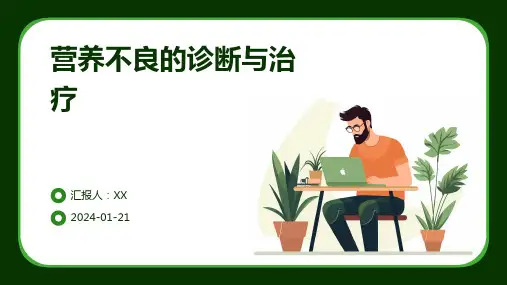

儿童营养不良诊疗常规营养不良一般指“蛋白质——能量营养不良”(PEM)。
【体格评价指标】用世界卫生组织(WHO)标准的中位数±标准差(SD)评价年龄的体重(W/A)、年龄的身高(H/A)、身高的体重(W/H)三个指标。
1.低体重:儿童的年龄的体重低于同年龄、同性别的2SD中度[X ( 2SD~ 3SD)],重度(<X 3SD)< p>2.生长迟缓:儿童的年龄的身高低于同年龄、同性别的2SD中度[X ( 2SD~ 3SD)],重度(<X 3SD)< p>3.消瘦:儿童的身高的体重低于同年龄、同性别的2SD中度[X ( 2SD~ 3SD)],重度(<X-3SD)< p>注:评价结果三者可不一致,因与缺乏的营养素在体内的生理生化功能有关。
【病因诊断】1.病史采集:喂养史、生长发育史、既往疾病史(反复感染、心肾肝疾病);2.临床表现:精神、运动、疾病情况等;3.体格检查:注意皮下脂肪、心肺肝脾、皮肤、毛发、肌力、肌张力等;4.实验室检查:血浆白蛋白降低,血清前白蛋白降低;5.营养计算:能量需要量和供给量计算体重应分三步,了解营养不良严重程度:(1)按实际PEM体重确定能量需要量;(2)按实际身高体重(消瘦儿童<实际身高体重的50%):供给量以108 kcal/kg计算(补充既往感染损失);(3)按实际年龄的平均体重计算:确定供给量(>以现有身高的体重确定)。
【治疗】1.治疗原发病:去除病因(如反复呼吸道感染和肠道感染);2.补充能量和蛋白质:按计算首先提供足量的能量需要量和供给量,然后据营养不良程度和消化功能状况,遵循由少增多的原则提高食物蛋白质量;3. 补充维生素和矿物质:膳食分析、体格检查、实验室检查证实伴有维生素A、C,B族维生素,锌、铁缺乏者等,可适当补充,促进康复;4. 治疗并发症:发生脱水、电解质紊乱、代谢性酸中毒、低蛋白血症等并发症时应及时纠正;5. 支持疗法:加强护理,预防感染、改善生活环境和个人卫生状况;轻度营养不良调整营养的同时可用中药、中医配合调理;中、重度营养不良儿童门诊治疗效果不理想的,应住院治疗。

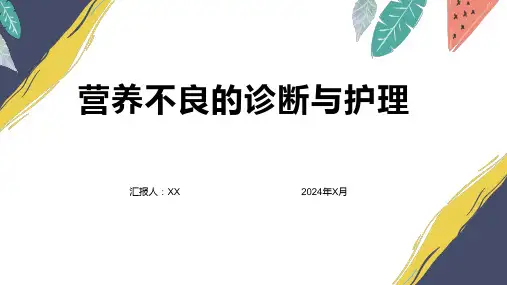

中重度营养不良标准
营养不良(malnutrition)通常指的是起因于摄入不足、吸收不良或过度损耗营养素所造成的营养不足,但也可能包含由于暴饮暴食或过度的摄入特定的营养素而造成的营养过剩。
营养不良一般可以分为三个程度:轻度、中度和重度。
具体标准如下:1、轻度营养不良:患者体重下降10%~20%,脂肪层变薄,肌肉不结实,皮肤松弛,但尚无生命危险。
2、中度营养不良:患者体重下降20%~40%,可有皮肤苍白、干燥、弹性减退,食欲减退,易疲乏无力,畏寒,心慌,头晕等症状,容易感染,腹泻,低血糖等。
3、重度营养不良:患者体重下降40%以上,显著消瘦,皮包骨头,精神萎靡,反应差,体温偏低,脉搏细弱,血压偏低,甚至出现重要脏器功能减退,容易发生感染,严重腹泻,低血糖昏迷等。
ESPEN endorsed recommendationDiagnostic criteria for malnutrition e An ESPEN Consensus StatementT.Cederholm a ,*,I.Bosaeus b ,R.Barazzoni c ,J.Bauer d ,A.Van Gossum e ,S.Klek f ,M.Muscaritoli g ,I.Nyulasi h ,J.Ockenga i ,S.M.Schneider j ,M.A.E.de van der Schueren k ,l ,P.Singer maDepartments of Geriatric Medicine,Uppsala University Hospital and Public Health and Caring Sciences,Clinical Nutrition and Metabolism,Uppsala University,Uppsala,Sweden bClinical Nutrition Unit,Sahlgrenska University Hospital and University of Gothenburg,Gothenburg,Sweden cDepartment of Medical,Surgical and Health Sciences,University of Trieste,Trieste,Italy d Department of Geriatric Medicine,Carl von Ossietzky Universit €a t,Oldenburg,Germany eDepartment of Gastroenterology,Clinic of Intestinal Diseases and Nutritional Support,Hopital Erasme,Free University of Brussels,Brussels,Belgium fGeneral and Oncology Surgery Unit,Stanley Dudrick's Memorial Hospital,Skawina,Poland gDepartment of Clinical Medicine,Sapienza University of Rome,Rome,Italy hDepartment of Nutrition and Dietetics and Department of Medicine,Monash University Central Clinical School,Prahran,Australia iDepartment of Gastroenterology,Hepatology,Endocrinology,and Nutrition,Klinikum Bremen Mitte,Bremen,Germany jDepartment of Gastroenterology and Clinical Nutrition,University Hospital and University of Nice Sophia-Antipolis,Nice,France kDepartment of Nutrition and Dietetics,Internal Medicine,VU University Medical Center,Amsterdam,The Netherlands lDepartment of Nutrition,Sports and Health,Faculty of Health and Social Studies,HAN University of Applied Sciences,Nijmegen,The Netherlands mDepartment of General Intensive Care,Institute for Nutrition Research,Rabin Medical Center,Sackler School of Medicine,Tel Aviv University,Petah Tikva 49100,Israela r t i c l e i n f oArticle history:Received 27February 2015Accepted 3March 2015Keywords:MalnutritionNutritional assessment Body composition De finition Consensus Delphis u m m a r yObjective:To provide a consensus-based minimum set of criteria for the diagnosis of malnutrition to be applied independent of clinical setting and aetiology,and to unify international terminology.Method:The European Society of Clinical Nutrition and Metabolism (ESPEN)appointed a group of clinical scientists to perform a modi fied Delphi process,encompassing e-mail communications,face-to-face meetings,in group questionnaires and ballots,as well as a ballot for the ESPEN membership.Result:First,ESPEN recommends that subjects at risk of malnutrition are identi fied by validated screening tools,and should be assessed and treated accordingly.Risk of malnutrition should have its own ICD Code.Second,a unanimous consensus was reached to advocate two options for the diagnosis of malnutrition.Option one requires body mass index (BMI,kg/m 2)<18.5to de fine malnutrition.Option two requires the combined finding of unintentional weight loss (mandatory)and at least one of either reduced BMI or a low fat free mass index (FFMI).Weight loss could be either >10%of habitual weight inde finite of time,or >5%over 3months.Reduced BMI is <20or <22kg/m 2in subjects younger and older than 70years,respectively.Low FFMI is <15and <17kg/m 2in females and males,respectively.About 12%of ESPEN members participated in a ballot;>75%agreed;i.e.indicated 7on a 10-graded scale of acceptance,to this de finition.Conclusion:In individuals identi fied by screening as at risk of malnutrition,the diagnosis of malnutrition should be based on either a low BMI (<18.5kg/m 2),or on the combined finding of weight loss together with either reduced BMI (age-speci fic)or a low FFMI using sex-speci fic cut-offs.©2015Elsevier Ltd and European Society for Clinical Nutrition and Metabolism.All rights reserved.1.IntroductionMalnutrition due to starvation,disease or ageing can be de fined as “a state resulting from lack of uptake or intake of nutrition leading to altered body composition (decreased fat free mass)and body cell mass leading to diminished physical and mental function*Corresponding author.Tel.:þ46702733192.E-mail address:tommy.cederholm@pubcare.uu.se (T.Cederholm).Contents lists available at ScienceDirectClinical Nutritionjournal h omepage:ht tp://w/locate/clnu/10.1016/j.clnu.2015.03.0010261-5614/©2015Elsevier Ltd and European Society for Clinical Nutrition and Metabolism.All rights reserved.Clinical Nutrition xxx (2015)1e 6and impaired clinical outcome from disease”[1].Although this definition is well-accepted,the condition lacks clear and generally accepted diagnostic criteria.During the famine catastrophes in Africa during the1960s,WHO brought attention to the medical aspects of starvation[2].The concepts of kwashiorkor and marasmus were introduced to define a particular protein deficient condition characterized by hypo-albuminemic peripheral edema and ascites,i.e.kwashiorkor,and a particular energy deficient state characterized by severe weight loss due to mainly fat store depletion,i.e.marasmus.This classifi-cation did not turn out as relevant for the recognition and diagnosis of malnutrition that was increasingly observed in hospitals in the Western countries during the later decades of the last century. Since depletion is usually a combined deficiency and loss of protein and energy,the general term of protein-energy malnutrition(PEM) became widely accepted[3].Clinical characteristics used to define PEM have varied over time,but there was never a consensus on diagnostic criteria.Various combinations of clinical,anthropo-metrical,biochemical and immunological measures were used(e.g. Refs.[4,5]).The last decades have seen the advent of several malnutrition screening tools that have reached increased acceptance due to their clinical feasibility.These screening tools combine about the same variables,i.e.weight loss,body mass index(BMI),signs of eating difficulties(e.g.appetite loss or reduced food intake)and a grading of on-going disease severity.ESPEN recognizes the following risk screening tools to be used in the hospital,elderly care and com-munity settings;Nutritional Risk Screening2002(NRS-2002),Mini Nutritional Assessment-Short Form(MNA-SF)and Malnutrition Universal Screening Tool(MUST)[6].The major use of these tools is to screen for malnutrition risk.The subsequent clinical actions should be assessment of underlying mechanisms and type of nutritional problems,in order to design personalized nutritional therapies.The diagnostic procedure usually ends there.The reasons for this are many-fold.One may be the imperative to focus on the implementation of the malnutrition risk screening procedures over the past years.Another apparent reason is the lack of consensus over diagnostic criteria.In the absence of such criteria,it is difficult to distinguish the effectiveness and efficacy of nutritional therapies when applied in different phases of the patients decline into malnutrition.The effects of nutritional therapy given at an early stage,before body protein and energy stores have been depleted, might differ as compared to when given at a late stage with overt depletion.Previous important consensus initiatives have been attempted [7e9],and the outcomes have reflected the complexity of the issue and the difficulties to reaching consensus.It was considered that these results“…may fuel the discussion within the nutritional societies,which will most ideally lead to an international consensus on a definition and operationalism of malnutrition”[7].There is moreover a confusion of terminology.Malnutrition, protein-energy malnutrition,undernutrition,depletion,wasting, cachexia are some of the terms used to denominate the condition that ensues deficiencies of macro-and micronutrients and catab-olism of protein and energy stores due to disease and ageing.The malnutrition-related concepts cachexia[10,11],sarcopenia[11,12] and frailty[13]are today well-established.The current initiative doesn't challenge their definitions.This statement is aimed at helping clinicians to effectively pro-vide therapeutic nutritional interventions,and accordingly,to document clinically relevant malnutrition,and moreover to facili-tate documentation in the Disease Related Group(DRG)and In-ternational Classification of Diseases(ICD)systems.Malnutrition should be recognized as a serious clinical risk factor.In real clinical settings this is not the case,partly due to the lack of simple and unequivocal diagnostic criteria.It is crucial to reach consensus on diagnostic criteria for malnutrition in order to unify the terminology(e.g.for ICD-10),to enhance the legitimacy of nutritional practices,to improve clinical care and to move the clinical and scientific nutritionfield forward.For this purpose the European Society of Clinical Nutrition and Metabolism(ESPEN) appointed a consensus group with a clear mission to provide criteria for the diagnosis of malnutrition.1.1.The consensus group objectivesThe primary objective was to reach consensus for simple,clear and generally applicable diagnostic criteria of malnutrition in the sense of energy and protein store depletion.The intention was to provide criteria that are independent from etiologic mechanisms, and that can be used for all patients and in all clinical settings.Secondary objectives were to try to bring clarity to the nutri-tional terminology,and to provide a general nutritional disorders concept tree.2.Methods2.1.Design of the delphi process and selection of the expert groupESPEN decided in late2012to launch the initiative.In January 2013representatives of more than40member countries of ESPEN outlined the initiative and acknowledged the process.An interna-tional expert group consisting of experienced clinical scientists was gathered to perform a modified Delphi process.The consensus group participants,i.e.the authors behind this report,were chosen to represent the clinicalfields of medicine,surgery,intensive care, oncology and geriatrics.It was agreed within the group to base the process on open e-mail communications,face-to-face meetings and on open as well as closed ballots within the group.The intention was to maintain the communication at each step until consensus for each milestone (see below)was reached among all participants before the next step was taken.Furthermore,the group agreed to seek the opinions of the ESPEN members before deciding on the statement.Finally,it was decided to perform validation studies of thefinal statement. This paper reports the process and outcome of the Delphi process, i.e.the consensus based malnutrition diagnostic criteria,while the validation studies are on-going and will be presented separately.2.2.Defined milestones of the processOverall there werefive major milestones defined for the project. These were to-decide the interrelationship between the screening and the diagnostic process.-identify the individual criteria that cover the crucial compo-nents of the condition for all patients in all settings.For the sake of feasibility,the goal was to use as few criteria as possible.-decide on whether and how the individual criteria should be combined to provide an expected high specificity of the diagnosis.-come up with clinically relevant cut-off values based on relevant reference populations for the chosen individual criteria.Finally,an independent milestone was to decide whether the term of undernutrition or malnutrition is to be preferred.T.Cederholm et al./Clinical Nutrition xxx(2015)1e6 23.Results3.1.How are screening and the diagnostic procedures interrelated?There was a strong consensus from e-mail communications,a one-day face-to-face meeting,and an anonymous group ballot that the diagnostic procedure has to be based on the outcome of a screening evaluation.Nutritional screening is always mandatory in all clinical and care settings,since it is unanimously recognized that patients affected by acute and chronic diseases are at high risk of developing nutritional impairment.Diagnostic measures are only needed for those cases that score positive for nutritional risk by any of the validated screening tools.This consensus group does not recommend any specific of the validated tools,as long as the tool is validated for the setting where it is applied.Screening should be sensitive,whereas diagnosis is specific.Thus,fewer will be diag-nosed as suffering from malnutrition than the number of subjects that are identified as being at risk.It was acknowledged that measurements that were performed during the screening process could potentially be used also for the diagnostic decision.“Risk of malnutrition”was suggested to be as a diagnosis with its own ICD Code.The general acceptance of the prevailing malnutrition screening tools relies on the fact that fulfilling the criteria for risk of malnutrition imposes negative clinical outcomes, including death.Therefore it is crucial to commence nutritional therapy as early as possible.Such intervention generates costs. Therefore,the diagnosis of being“at risk of malnutrition”needs to be coded and reimbursed in the ICD and DRG systems.3.2.Which individual criteria do best capture the state of malnutrition?Nutritional variables are traditionally categorized as measures of anthropometry,including body composition,biochemical in-dicators and data related to eating capability.The latter include history as well as recording of actual food intake,or information on factors for potential limitations of food intake like anorexia, dysphagia or chewing problems.A one-day face-to-face meeting was organized to scrutinize these potential diagnostic criteria.Functional measures of strength or power were soon dismissed as part of the diagnosis since they were consensually viewed as not nutrition specific enough.Thus, the following variables,or group of variables,were discussed as potential criteria.3.2.1.AnthropometryBMI and leg and arm anthropometry,e.g.calf circumference, arm muscle circumference and triceps skinfold,are clinically available objective variables with a fairly wide-spread use.3.2.2.Body compositionFat free mass(FFM)and fat mass(FM)can objectively be measured by technical devices like bioelectrical bio-impedance analyses(BIA),dual energy x-ray absorptiometry(DXA), computed tomography(CT),ultrasound or magnetic resonance imaging(MRI).3.2.3.Weight lossThis reflects a dynamic process that requires a negative energy balance;i.e.a reduced food intake or increased energy expenditure.3.2.4.AnorexiaLoss of appetite is a common complication to disease,medica-tion and ageing.It is one of the most important mechanisms behind weight loss.3.2.5.Reduced food intakeSelf-reported or quantified reduction of the food intake is a feature of most of the screening tools.3.2.6.Biochemical indicatorsMarkers of visceral protein status,like serum concentrations of albumin have a tradition of being used as markers of nutritional status.Inflammation,due to disease or ageing,is likely the most common cause underlying the development of malnutrition.Thus, inflammation is an important etiologic factor for malnutrition. 3.2.7.Subjective professional evaluationAfter the screening procedure has identified subjects at nutri-tional risk,a subjective evaluation of body composition and phys-ical function performed by experienced health professionals could indicate the diagnosis of malnutrition.3.3.The result of the criteria ballot in the consensus groupAs a result of the consensus group face-to face meeting,a questionnaire was constructed and provided to all group members where they were asked to grade their degree of acceptance from1 to6to include the following variables as one of the diagnostic criteria;i.e.weight loss,reduced BMI,reduced fat free mass index (FFMI),reduced fat mass index(FMI),reduced food intake,reduced appetite,a biochemical marker(visceral proteins or inflammatory markers),or a subjective evaluation of a professional.The response of the questionnaire was anonymous for all but the facilitator(TC). The scores of1e2,3e4and5e6were denoted against,middle and pro,respectively.Figure1shows the result of the ballot.A fairly clear pattern emerged,as there was a preference in the group for the use of weight loss,reduced BMI and reduced FFMI.The ensuing e-mail discussion confirmed that the term weight loss would encompass significant reductions in food intake,appe-tite loss,and for any imbalance between nutrient requirements and intake.Thus,evaluations of food intake and appetite will not add further information beyond weight loss.Nevertheless,data on intake and appetite are important for screening for malnutrition risk.Next BMI was discussed.Low BMI is commonly accepted in the medical community,and received support from the majority of the consensus group to be one criterion.However,BMI can be misleading as the growing obesity epidemic renders a number of seriously ill and malnourished patients in the normal BMI range although they may have lost a considerable and clinicallyrelevantFig.1.Outcome of the questionnaire on the preference of the individual criteria.Group members were asked to grade from1to6;1¼total disagreement and6¼total agreement,on the use of each criterion.Scores of1e2was aggregated to being against, scores of5e6as being for(pro)and3e4as in between(middle).T.Cederholm et al./Clinical Nutrition xxx(2015)1e63amount of body mass.Due to several question marks on the use of BMI for malnutrition diagnosis some of the consensus group members suggested to omit BMI as a potential criterion.Never-theless in thefinal analysis it was unanimously decided to keep BMI for thefinal selection,due to the fact that BMI has a well-validated outcome predictive value.For body composition,the pros and cons of fat mass and fat free mass to reflect nutrition status was discussed.One incentive for ESPEN to launch this malnutrition diagnosis initiative was to test the grounds for promoting body composition measures for diag-nostic rmation on relative amounts of fat mass and fat free mass provides far more valuable information than BMI alone,both from functional and metabolic points of view.FFM,i.e. mainly the muscle mass was considered to provide the most rele-vant information.Muscle confers ability to activity,acts as the amino acid pool and is important for energy expenditure and glucose metabolism[14].According to biochemical indicators,the perception was that visceral proteins like serum albumin concentrations are good in-dicators of disease severity and outcome.Inflammation is today considered the major reason for reduced serum levels of visceral proteins.Thus,visceral proteins should not be used for either screening or diagnosis of malnutrition.The low grade of nutrition specificity was the major reason for this decision.The question of integrating a biochemical indicator of inflammatory activity,e.g.C-reactive protein,into the diagnostic format raised another discus-sion.Inflammation has a central etiologic role for catabolism and is an integral feature of cachexia.Thus,inflammation is rather to be regarded as an etiologic factor than a diagnostic feature of malnutrition.The same reasoning goes for indicators of potential anabolic activity,e.g.insulin-like growth factor-1.The Consensus group decided that all criteria should be objec-tive as far as possible.Diagnosis by subjective evaluation by an experienced health professional did not meet this criterion.3.4.Is there an optimal combination of criteria?Thus,three variables were chosen to most accurately reflect malnutrition,namely weight loss,reduced BMI and reduced FFMI. The next question was whether and how to combine the variables to best capture the diagnosis.For this purpose the group performed a second anonymous ballot based on a questionnaire that comprised nine options.For each option,any of the three favored variables was suggested to be mandatory and combined with one or both of the other two vari-ables.Eight out of ten answers were positive for the option where unintentional weight loss should be mandatory,and weight loss should be combined with either reduced BMI or with reduced FFMI. Consensus was reached to suggest both alternatives,i.e.either weight loss and reduced BMI,or weight loss and reduced FFMI, should give the diagnosis of malnutrition.In real clinical life access to body composition measurements is limited,which justifies keeping both alternatives.3.5.Which are the clinically relevant cut-off values for the chosen individual criteria?The next challenge was tofind valid and clinically relevant cut-off values for weight loss,BMI and FFMI.3.5.1.Weight lossWeight loss trajectories differ with clinical condition.Never-theless,involuntary weight loss is a strong predictor of negative outcomes irrespective of magnitude,speed and underlying cause. Naturally,a massive and fast weight loss due to an aggressive cancer disease imposes a higher risk than a smaller and slower weight loss due to ageing.Thus,consensus was reached to propose two optional cut-offs for unintentional weight loss;i.e.either>5%over the last3 months to cover for acute illnesses,or>10%of habitual weight indefinite of time to be relevant for chronic conditions.3.5.2.BMIWHO advocates BMI<18.5kg/m2as a general cut-off for un-derweight.This cut-off is justified at a public health population level[15],whereas its relevance for clinical and care settings may be questioned.As already mentioned the trend of increasing BMI in all populations world-wide make this acknowledged BMI cut-off value difficult to use for the purpose of defining malnutrition.Pa-tients struck with highly catabolic diseases may in3e6months lose substantially more than10%of their weight and still have BMI values well above“normal”ranges.Another issue to consider is that epidemiological evidence indicates that older populations display higher optimal BMI intervals(e.g.for survival)than younger people.Partly due to the strong global acceptance of the WHO cut-off of 18.5kg/m2it was decided unanimously to accept the WHO rec-ommended cut-off of as a criterion that in its own right will be enough to diagnose malnutrition.With this latter decision it was easy to come to consensus for a complementary suggestion for relevant BMI cut-off values;namely <20kg/m2for subjects<70years of age,and<22kg/m2for subjects 70years and older,remembering the fact that these BMI levels need to be linked to weight loss as defined above.The choices of20and 22kg/m2,respectively,were based on consensus in the group. Ethnic and regional variability in BMI may need to be considered.3.5.3.FFMICut-offs for FFMI need to be linked to the decided cut-offs for BMI on one hand,and to the fact that women have lower FFMI(and higher FMI)than men on the other hand.Based on Swiss reference material[16]it was decided to suggest FFMI<15and<17kg/m2in women and men,respectively.It has to be emphasized that refer-ence values,like for BMI,should be relevant for the specific ethnic and cultural context that is at hand.The result of this process is summarized in the Fact box.3.6.ESPEN membership ballotFor transparency,implementation and awareness purposes the final consensus group suggestion for the malnutritiondiagnosticT.Cederholm et al./Clinical Nutrition xxx(2015)1e6 4criteria was presented to the membership of ESPEN to vote for.The ESPEN Newsletter provided the questionnaire by e-mail to all members (~around 3000world-wide).Members were asked to grade their acceptance of the suggestion,as presented in the Fact box,on a scale from 1(very low)to 10(very high).Altogether 344members gave their vote.Figure 2shows the result of the poll;i.e.>75%of the voting members gave a score of 7or more in agreement of the suggestion.A score of 4or less indicating disagreement was given by 10%of the voters.According to the given comments from the members that gave low scores,the absence of functional measures was the major reason for disagreement.3.7.Terminology of malnutrition or undernutrition and the conceptual tree of nutritional disordersThe general perception of the group was that malnutrition and undernutrition is about equally used in the scienti fic literature and in clinical practice,with a slight preponderance for malnutrition.A potential problem with the term malnutrition is that it literally covers all deviating nutritional states.In the first in-group ballot performed,the group members were asked to anonymously state their preference.The two terms received an equal number of votes,i.e.5vs 6.The pro and con arguments were not strongly in favor of any of the terms and it was decided to leave the question open for the ESPEN member ballot to give a stronger advice.Thus,in the same ESPEN Newsletter that encouraged ESPEN members to vote for or against the suggested diagnostic criteria (see above),the members were also asked to give their opinion on whether they preferred the term of malnutrition or of undernu-trition.The vote came out as indecisive and split as in the smallerpoll among the consensus group.Malnutrition had a slight pre-ponderance with 53%of the votes as compared to 47%in favor of undernutrition.Due to this uncertain result the consensus group doesn't advocate any speci fic term,but has chosen to use malnu-trition for this paper.Finally,a conceptual tree of prevailing nutritional disorders was constructed (Fig.3),acknowledging the complex interactions be-tween the conditions.The structure of Fig.3was discussed as some in the consensus group preferred a less hierarchical arrangement of the conditions.4.DiscussionThis ESPEN Consensus Statement provides a novel,compre-hensive,yet simple,format for the diagnosis of malnutrition.The statement acknowledges the well-accepted BMI cut-off of 18.5kg/m 2provided by WHO.In addition,it introduces an alternative and partly new format based on the combination of unintentional weight loss,and low BMI or low FFMI,where the latter drives the necessity to use modern techniques for body composition mea-surements.Regarding BMI,there was unanimous consensus that,in the presence of signi ficant weight loss,BMI levels higher than 18.5kg/m 2may also re flect suf ficiently altered nutritional state to warrant the diagnosis of malnutrition.The proposed cutoff values of 20(<70y)and 22( 70y)kg/m 2was the result from consensus within the group.Validation studies have been launched to possibly con firm these indications.Recent years have seen the development of several malnutrition screening tools,for example NRS-2002,MNA-SF and MUST,which should be used for everybody that comes in contact with health and elderly care.The purpose is to identify the individuals that will need further nutritional assessment and that will need nutritional therapy,in order to prevent the further nutritional deterioration into malnutrition.To be de fined as “at risk ”for malnutrition ac-cording to any of the validated screening tools should render its own ICD Code.Many of the validated screening tools in clinical use today also provide grading into manifest malnutrition as well,which is somewhat beyond their primary purpose.Since NRS-2002,MNA-SF and MUST use different criteria and cut-offs,and were designed for different purposes and populations [17],the preva-lence of malnutrition in a speci fic population will differ with the screening tool used.Moreover,as indicated the appropriate eval-uation of nutritional therapy effects is affected by when the therapy is applied,i.e.in late or early phases of malnutrition,as well as by variations in the diagnostic criteria [18].These examples illustrate how acknowledgment and development of clinical nutrition may suffer from the lack of clear diagnostic criteria for malnutrition.As indicated the purpose of this initiative was to provide a general diagnosis that is relevant for all subjects in all clinical set-tings.Recent years have seen the advent of improved conceptual-ization and better understanding of different forms of nutritional disorders and malnutrition (Fig.3).Nevertheless,the de finition is meant to be valid for all individuals no matter if starvation,acute or chronic disease or ageing is the dominant underlying cause of the state of malnutrition.As with all general diagnoses (compare anemia)they need to be elaborated into sub-diagnoses which indicate their etiologies to facilitate the best treatment.Thus,this ESPEN statement also provides a conceptual tree where pure star-vation,disease-related malnutrition (cachexia)[10,11],and the concepts of sarcopenia [11,12]and frailty [13]are related to,and at least partly over-arched by the general term of malnutrition.The concepts of cachexia and sarcopenia pinpoint the impor-tance of variations in body composition,i.e.fat and muscle mass,as predictors of clinical outcome.The two-compartment model for body composition,i.e.FMI and FFMI,offers a moreprecise“We want you to indicate on a scale from 1to 10whether you agree strongly ¼10,or disagree strongly ¼1,with this suggestion ”(see Factbox).Fig.3.A conceptual tree of nutritional disorders.T.Cederholm et al./Clinical Nutrition xxx (2015)1e 65。